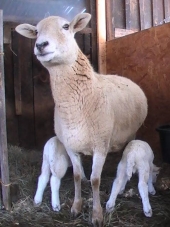
 2
2




 2
2




"When the whole world is running towards a cliff, he who is running in the opposite direction appears to have lost his mind." C.S. Lewis
Visit https://themaineingredient.com for organic, premium dried culinary herbs that are grown, processed, and packaged in the USA.
 1
1




Invasive plants are Earth's way of insisting we notice her medicines. Stephen Herrod Buhner
Everyone learns what works by learning what doesn't work. Stephen Herrod Buhner
 3
3




 6
6




Come join me at www.peacockorchard.com
 3
3




Matt McSpadden wrote:I will start by assuring you that I have very little experience with pigs... just hoping to bump this a little.
Having said that, as a general rule, I see that the heritage breeds of animals tend to be more disease resistance and self reliant. My favorite pig breed that I want to get eventually are the American Guinea Hogs. Smaller, good on forage good temperament, and really good eating. Up there with the mangalitsa according to some... though I have not seen a side by side blind taste test.
 4
4




With appropriate microbes, minerals and organic matter, there is no need for pesticides or herbicides.
 2
2




 3
3




Find me at http://www.powellacres.com/




